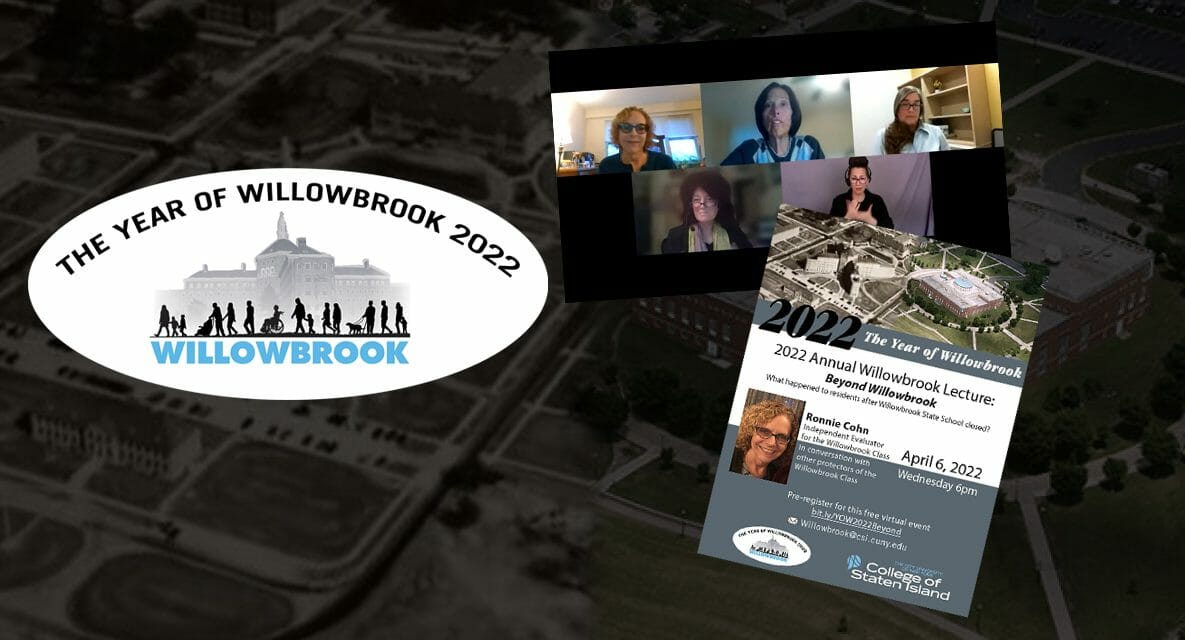As part of the 2022 Year of Willowbrook at the College of Staten Island, the Willowbrook Legacy Project presented its 29th Annual Willowbrook Memorial Lecture entitled “Beyond Willowbrook” on Wednesday, April 6. The signature event of the month, held virtually on Zoom, focused on what happened to residents of the Willowbrook State School after the institution closed.
After opening remarks from Willowbrook Legacy Project Co-chair Nora Santiago, the panel was introduced by Dr. Russell Rosen, Coordinator of the Disability Studies Minor and the Program in American Sign Language (ASL) at CSI, who talked about the importance of the lecture and the impact that the panelists had and continue to have as advocates to the Willowbrook class.
Dr. Rosen then introduced Ronnie Cohn, the Independent Evaluator for the Willowbrook Class, who headlined the panel. Cohn was charged with ensuring that former Willowbrook residents were protected after the closure of Willowbrook in 1987. She talked about the critical time after the Consent Judgement that led to the Willowbrook closure, ensuring care and conditions for the Willowbrook class at the time, which consisted of over 5,000 individuals.
Cohn introduced other members of the panel who also reflected on their roles in the wake of the Willowbrook closure, and today as advocates for those with intellectual and developmental disabilities. Panel guests included Beth Haroules, Senior Staff Attorney at the New York Civil Liberties Union, and the NYCLU Plaintiffs’ lead attorney; Kathy Broderick, former Associate Commissioner of the Office for People With Developmental Disabilities (OPWDD) and AHRC NYC staff member; and Tawnie Ferguson, Executive Director, Consumer Advisory Board.
In addition to the panelists, the Annual Willowbrook Memorial Lecture featured greetings from Kerri Neifeld, Commissioner of the New York State OPWDD.
Following reflections and comments from the panelists, Willowbrook Legacy Project Committee Co-chair Dr. Catherine Lavender led a question-and-answer segment with questions pulled from the over 150 attendees.
For more than thirty years, The Willowbrook Memorial Lecture Series has provided an ongoing focus on preserving and publicizing the history of Willowbrook and its legacy in the lives of persons with IDD and other disabilities today. The lecture series was created by Professor Emeritus Dr. David Goode.
The Zoom event was captured on video and is available for viewing through the Willowbrook YouTube channel. ASL interpretation courtesy of Anna Carter and Nicole Safford is also provided throughout.
For more information about The Year of Willowbrook, visit their Website or send email to willowbrook@csi.cuny.edu.
About Willowbrook State School and The Willowbrook Mile
Willowbrook State School was the largest institution in the world in which people with disabilities were locked away from society. In 1938, the New York State Legislature had authorized the building of a school for what they then termed “mental defectives.” The Willowbrook site was selected and the buildings erected in the early 1940s. However, when the U.S. entered the Second World War, the site was turned over to the military for use as a hospital and prisoner-of-war camp, Halloran Hospital, and operated in that capacity until 1951. As Halloran Hospital was closing down, the property returned to its original intended purpose as the Willowbrook State School. It opened in 1947, intended to serve as a model of treatment for persons with intellectual and other disabilities.
When it opened, Willowbrook attempted to provide better care in an institutional setting than could be provided at home. However, the mere scope and size of the more-than-380-acre Willowbrook State School impaired its ability to provide normal, personalized comfort and care. As conditions worsened, a group of residents’ families and staff urged change. By the 1970s, they invited reporters to share the story more widely. Media coverage and this activism led to a lawsuit resulting in a 1975 Consent Judgement ordering that Willowbrook residents receive humane treatment and adequate clinical and educational services. This also set in motion the eventual closure of Willowbrook in 1987 and began the development of community-based services. Along with the 1975 Education for All Handicapped Children Act, the Willowbrook Judgement helped lead to later key legal protections, including the 1990 Americans with Disabilities Act (ADA).
In the early 1990s, spurred by a conviction that nothing like the Willowbrook story should ever happen again, the Staten Island Developmental Disabilities Council, the primary advocacy group on Staten Island for persons with disabilities and their families, formed the Willowbrook Property Planning Committee. They began to work on collecting and preserving the history of the Willowbrook State School and to increase the visibility of the stories of those who had once lived and worked in the facility.
In the 2010s, the Staten Island Developmental Disabilities Council partnered with the other stakeholders on the Willowbrook site: the College of Staten Island/CUNY, the Institute for Basic Research (IBR), and the Office for People with Developmental Disabilities (OPWDD) – to establish a memorial walking trail that has become the Willowbrook Mile. The Mile is designed to preserve the site’s history, and to create a visionary presence that commemorates the social justice and deinstitutionalization movement to ensure the rights of all persons to live with dignity and thrive in their communities.


![[videos, galleries] 67th Commencement Celebrates Student Achievement](https://csitoday.com/wp-content/uploads/2016/06/Commencement-2016.jpg)














